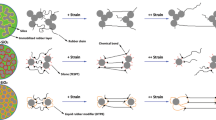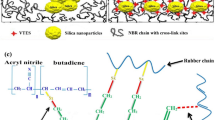Abstract
This study shows how carbon black/silica hybrid filler networking leads to synergistic properties in styrene-butadiene rubber (SBR) composites. The effects of low concentrations of silica, the secondary filler, on flocculation and network formation/breakdown (Payne effect) of carbon black, the primary filler in the SBR composites, were evaluated. There was a critical silica concentration at which this synergy was observed, but it disappeared at higher concentrations due to network formation by silica itself. A mismatch between the carbon black and silica surface energies was shown to be the determining parameter. Critical loading of silica was also observed for vulcanization of rubber composites, at which the enthalpy of vulcanization increased considerably. Enhancements in the final properties, such as mechanical strength and wear resistance, were explained by improvements in the dispersion of carbon black and vulcanization of rubber at the critical loading of silica.
This is a preview of subscription content, access via your institution
Access options
Subscribe to this journal
Receive 12 print issues and online access
$259.00 per year
only $21.58 per issue
Buy this article
- Purchase on Springer Link
- Instant access to full article PDF
Prices may be subject to local taxes which are calculated during checkout














Similar content being viewed by others
References
Natarajan B, Li Y, Deng H, Brinson LC, Schadler LS. Effect of interfacial energetics on dispersion and glass transition temperature in polymer nanocomposites. Macromolecules. 2013;46:2833–41.
Stockelhuber K, Svistkov A, Pelevin A, Heinrich G. Impact of filler surface modification on large scale mechanics of styrene butadiene/silica rubber composites. Macromolecules. 2011;44:4366–81.
Leblanc JL. Rubber–filler interactions and rheological properties in filled compounds. Prog Polym Sci. 2002;27:627–87.
Choi S-S, Ko E. Novel test method to estimate bound rubber formation of silica-filled solution styrene-]][butadiene rubber compounds. Polym Test. 2014;40:170–7.
Stöckelhuber K, Wießner S, Das A, Heinrich G. Filler flocculation in polymers–a simplified model derived from thermodynamics and game theory. Soft Matter. 2017;13:3701–9.
Fritzsche J, Klüppel M. Structural dynamics and interfacial properties of filler-reinforced elastomers. J Phys: Condens Matter. 2010;23:035104.
Mujtaba A, Keller M, Ilisch S, Radusch H-J, Beiner M, Thurn-Albrecht T, et al. Detection of surface-immobilized components and their role in viscoelastic reinforcement of rubber–silica nanocomposites. ACS Macro Lett. 2014;3:481–5.
Bohm G, Tomaszewski W, Cole W, Hogan T. Furthering the understanding of the non linear response of filler reinforced elastomers. Polymer. 2010;51:2057–68.
Sugimoto S, Inutsuka M, Kawaguchi D, Tanaka K. The effect of interfacial dynamics on the bulk mechanical properties of rubber composites. Polym J. 2020;52:217–23.
Mujtaba A, Keller M, Ilisch S, Radusch H-J, Thurn-Albrecht T, Saalwachter K, et al. Mechanical properties and cross-link density of styrene–butadiene model composites containing fillers with bimodal particle size distribution. Macromolecules. 2012;45:6504–15.
Paran SMR, Karimi M, Saeb MR. Fabrication methods of carbon-based rubber nanocomposites. In: Carbon-based nanofillers and their rubber nanocomposites. Elsevier: Amsterdam; 2019. p. 355–80.
Jing Y, Niu H, Li Y. Improved ethylene-propylene rubber/silica interface via in-situ polymerization. Polymer. 2019;172:117–25.
Song SH. Effect of surfactants on MWNT filled elastomer composites by latex mixing. Polym Eng Sci. 2018;58:1843–8.
Hosseini SM, Torbati-Fard N, Kiyani H, Razzaghi-Kashani M. Comparative role of interface in reinforcing mechanisms of nano silica modified by silanes and liquid rubber in SBR composites. J Polym Res. 2016;23:203.
Bonnevide M, Jimenez AM, Dhara D, Phan TN, Malicki N, Abbas ZM, et al. Morphologies of polyisoprene-grafted silica nanoparticles in model elastomers. Macromolecules. 2019;52:7638–45.
Bonnevide M, Phan TN, Malicki N, Kumar SK, Couty M, Gigmes D, et al. Synthesis of polyisoprene, polybutadiene and Styrene Butadiene Rubber grafted silica nanoparticles by nitroxide-mediated polymerization. Polymer. 2020;190:122190.
Zhao G, Shi L, Zhang D, Feng X, Yuan S, Zhuo J. Synergistic effect of nanobarite and carbon black fillers in natural rubber matrix. Mater Des. 2012;35:847–53.
Feng W, Tang Z, Weng P, Guo B. Correlation of filler networking with reinforcement and dynamic properties of SSBR/carbon black/silica composites. Rubber Chem Technol. 2015;88:676–89.
Tang Z, Zhang C, Wei Q, Weng P, Guo B. Remarkably improving performance of carbon black-filled rubber composites by incorporating MoS2 nanoplatelets. Compos Sci Technol. 2016;132:93–100.
Etika KC, Liu L, Hess LA, Grunlan JC. The influence of synergistic stabilization of carbon black and clay on the electrical and mechanical properties of epoxy composites. Carbon. 2009;47:3128–36.
Sattayanurak S, Sahakaro K, Kaewsakul W, Dierkes WK, Reuvekamp LA, Blume A, et al. Synergistic effect by high specific surface area carbon black as secondary filler in silica reinforced natural rubber tire tread compounds. Polym Test. 2020;81:106173.
Hassankhani H, Atashi H, Mohebbi-Kalhori D. Reducing of heat loss of rubber compound using natural zeolite filler: effect of partially substitution of fillers on compound properties. Iran Polym J. 2018;27:555–61.
Aghajan MH, Hosseini SM, Razzaghi-Kashani M. Particle packing in bimodal size carbon black mixtures and its effect on the properties of styrene-butadiene rubber compounds. Polym Test. 2019;78:106002.
Galimberti M, Agnelli S, Cipolletti V. Hybrid filler systems in rubber nanocomposites. In: Progress in Rubber Nanocomposites. Elsevier: Amsterdam; 2017. p. 349–414.
Jafarpour E, Shojaei A, Ahmadijokani F. High-performance styrene-butadiene rubber nanocomposites based on carbon nanotube/nanodiamond hybrid with synergistic thermal conduction characteristics and electrically insulating properties. Polymer. 2020;196:122470.
Shiva M, Lakhi M. Studying the effects of silica/alumina and silica/boehmite binary filler on the mechanical properties and the non-isothermal curing time of carbon black filled tyre tread composite. Compos B Eng. 2019;175:107124.
Abdul Salim ZAS, Hassan A, Ismail H. A review on hybrid fillers in rubber composites. Polym Plast Technol Eng. 2018;57:523–39.
Rooj S, Das A, Stöckelhuber K, Wießner S, Fischer D, Reuter U, et al. ‘Expanded organoclay’assisted dispersion and simultaneous structural alterations of multiwall carbon nanotube (MWCNT) clusters in natural rubber. Compos Sci Technol. 2015;107:36–43.
Hosseini SM, Razzaghi-Kashani M. Catalytic and networking effects of carbon black on the kinetics and conversion of sulfur vulcanization in styrene butadiene rubber. Soft Matter. 2018;14:9194–208.
Hosseini SM, Razzaghi-Kashani M. Vulcanization kinetics of nano-silica filled styrene butadiene rubber. Polymer. 2014;55:6426–34.
Hentschke R. The Payne effect revisited. eXPRESS Polym Lett. 2017;11:278–92.
Maier P, Goritz D. Molecular interpretation of the Payne effect. Kautsch Gummi Kunstst. 1996;49:18–21.
Mahtabani A, Alimardani M, Razzaghi-Kashani M. Further evidence of filler–filler mechanical engagement in rubber compounds filled with silica treated by long-chain silane. Rubber Chem Technol. 2017;90:508–20.
Meier JG, Klüppel M. Carbon black networking in elastomers monitored by dynamic mechanical and dielectric spectroscopy. Macromol Mater Eng. 2008;293:12–38.
Israelachvili JN. Intermolecular and surface forces: Academic Press: Amsterdam; 2015.
Wang M-J. Effect of polymer-filler and filler-filler interactions on dynamic properties of filled vulcanizates. Rubber Chem Technol. 1998;71:520–89.
Torbati-Fard N, Hosseini SM, Razzaghi-Kashani M. Effect of the silica-rubber interface on the mechanical, viscoelastic, and tribological behaviors of filled styrene-butadiene rubber vulcanizates. Polym J. 2020;52:1223–34.
Mortezaei M, Mohammad Hossein Navid F, Mohammad, Reza K. Effect of immobilized interfacial layer on the maximum filler loading of polystyrene/silica nanocomposites. J Reinf Plast Compos. 2011;30:593–9.
Litvinov V, Orza R, Kluppel M, Van Duin M, Magusin P. Rubber–filler interactions and network structure in relation to stress–strain behavior of vulcanized, carbon black filled EPDM. Macromolecules. 2011;44:4887–900.
Hosseini SM, Razzaghi-Kashani M. On the role of nano-silica in the kinetics of peroxide vulcanization of ethylene propylene diene rubber. Polymer. 2017;133:8–19.
Raef M, Hosseini SM, Nabavian Kalat M, Razzaghi‐Kashani M. Vulcanization kinetics of styrene butadiene rubber reinforced by graphenic particles. SPE Polym. 2021;2:122–33.
Jafari F, Razzaghi‐Kashani M, Hosseini SM, Pourhossaini MR. Effects of modified poly (tetrafluoroethylene) on the p hysico‐mechanical and tribological properties of carbon‐black filled nitrile‐butadiene rubber. J Appl Polym Sci. 2021;138:50061.
Author information
Authors and Affiliations
Corresponding author
Ethics declarations
Conflict of interest
The authors declare no competing interests.
Additional information
Publisher’s note Springer Nature remains neutral with regard to jurisdictional claims in published maps and institutional affiliations.
Rights and permissions
About this article
Cite this article
Amrollahi, A., Razzaghi-Kashani, M., Hosseini, S.M. et al. Carbon black/silica hybrid filler networking and its synergistic effects on the performance of styrene-butadiene rubber composites. Polym J 54, 931–942 (2022). https://doi.org/10.1038/s41428-022-00630-2
Received:
Revised:
Accepted:
Published:
Issue Date:
DOI: https://doi.org/10.1038/s41428-022-00630-2
This article is cited by
-
Mechanism of the effect of nano-silica on crack growth and wear resistance of natural rubber-based composites
Journal of Materials Science (2023)



